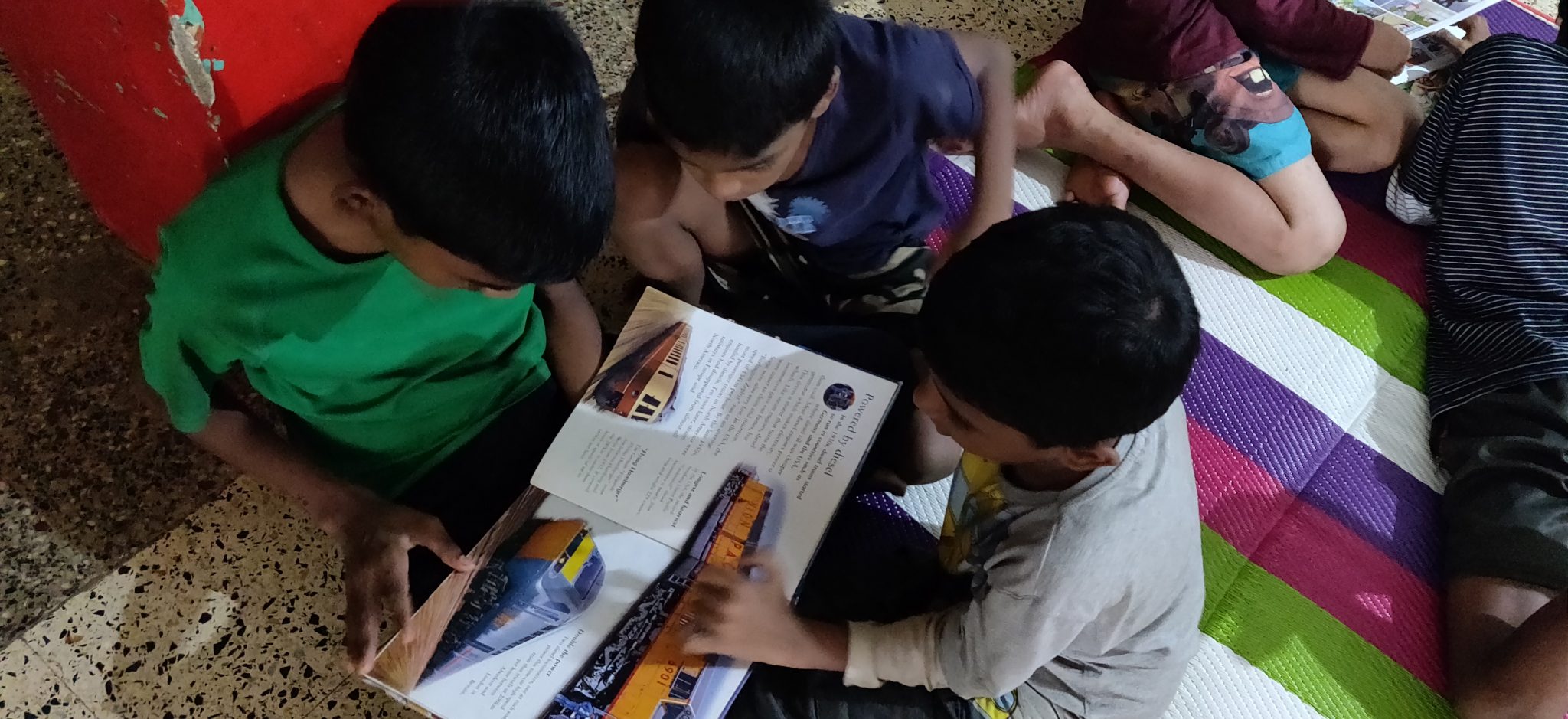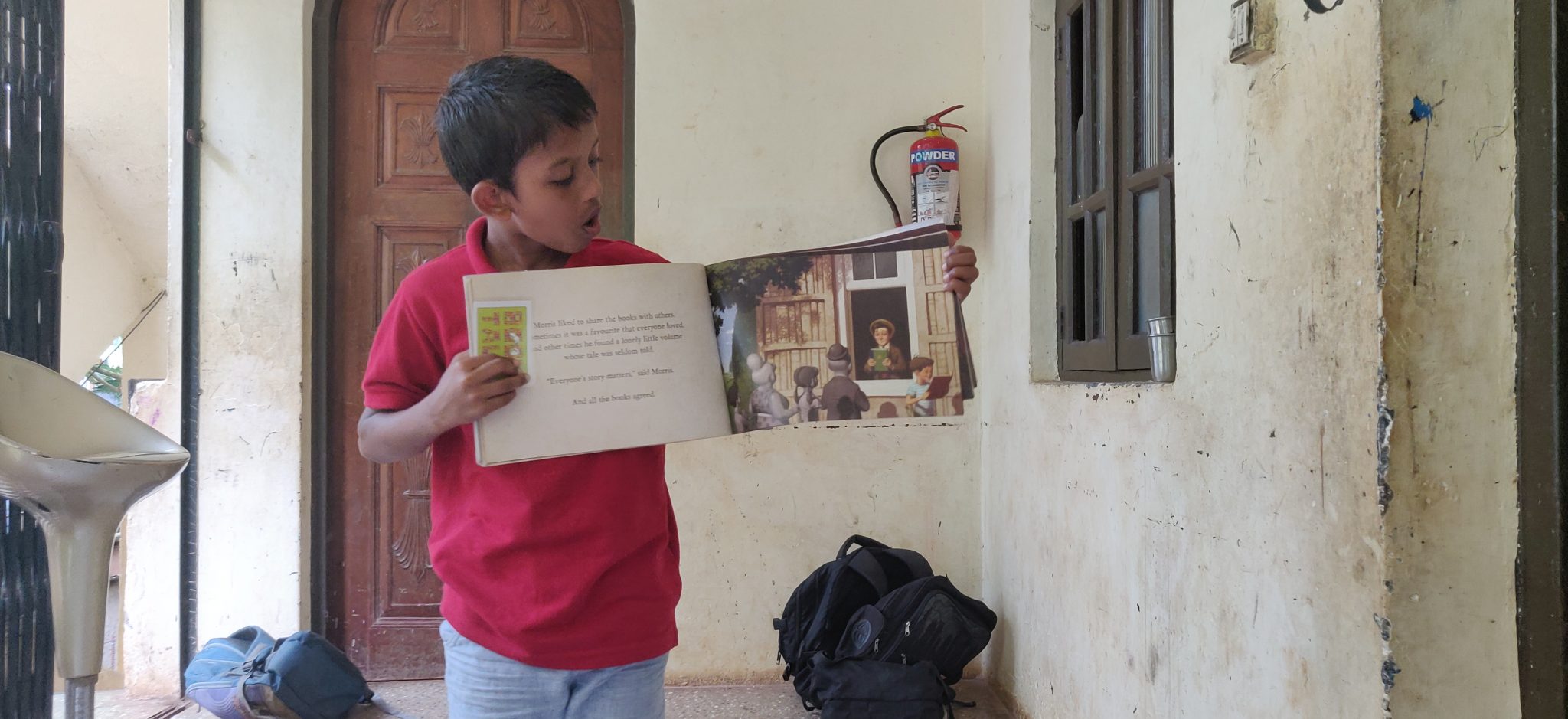Often when people think of what a library session does, they imagine it simply as a session that would help in learning to read, and to build some literacy skills. But how do we talk about everything else that happens when we listen and interact with stories?
During our library sessions, there are some things that flow though all our sessions, in schools, in communities, in the library, with children and with adults: Creating a space where there is no right answer, where every response is accepted and discussed, an encouragement to make their own connections with books, with each other, with us, and with stories, and a firm understanding that the library space and session is OPEN. Often with these nuances, other skills, such as the ability to think critically, to question, and other literacy skills, emerge effortlessly.  The thoughts that emerge when we listen and accept every response, are precious. During one of our weekly Mobile Outreach sessions, we read aloud the story, Putul and the Dolphins by Mariam Karim Ahlawat, a story about choices. When the phrase ‘the river is both a friend and an enemy’ came up, Salman beautifully explained how the river helps us by giving fish and in other ways but it can also flood and destroy everything.
The thoughts that emerge when we listen and accept every response, are precious. During one of our weekly Mobile Outreach sessions, we read aloud the story, Putul and the Dolphins by Mariam Karim Ahlawat, a story about choices. When the phrase ‘the river is both a friend and an enemy’ came up, Salman beautifully explained how the river helps us by giving fish and in other ways but it can also flood and destroy everything.
At the end of this story, Putul makes the choice to save the dolphins, despite being in a situation where she and her family are hungry and capturing and selling dolphins would definitely have brought in money for food. When we asked what would they have done if they were in Putul’s place, a number of them said that they would have saved the dolphins but one child said that we are saying this now, after sitting here and listening to this story, but if we really were in that situation and had to choose between catching the dolphins or saving them, we may not have thought of the dolphins and may only have thought of our hunger. This started a discussion on what would they have actually done in this situation. By creating a space where questions and responses freely fly back and forth and there is no one right answer, each one is open to responding without judgement, to thinking and reflecting at a level much deeper than surface thoughts, and to being open to different ways of thinking and doing things.
The connections that are made in between stories are another lovely thing to experience. During a Book Talk by Tejas on the book ‘The Red Umbrella’ by Nandani Nayar and illustrated by Sowmya Menon, Prem remembered the story ‘The Mitten’ by Jan Brett, the plot of which is similar to ‘The Red Umbrella’, although the context completely different. Often while book browsing, or during Book Talks or a Read Aloud, a voice will often call out another story that was similar to this story. And these are stories not always similar in plot or characters, but often stories similar in themes.  Another discussion that often comes up following stories, is whether the story actually happened. Did Basava actually follow the fireflies home? Did the Drum Dream girl actually do all these things? Do these places really exist? Following the Read Aloud of Race of the Rivers written by Esther Syiem and illustrated by Benedict Hynniewta, a folktale based in Meghalaya, the children agreed that birds perhaps could talk in earlier times, but they didn’t think that people could actually change into rivers and hence this was probably not a true story.
Another discussion that often comes up following stories, is whether the story actually happened. Did Basava actually follow the fireflies home? Did the Drum Dream girl actually do all these things? Do these places really exist? Following the Read Aloud of Race of the Rivers written by Esther Syiem and illustrated by Benedict Hynniewta, a folktale based in Meghalaya, the children agreed that birds perhaps could talk in earlier times, but they didn’t think that people could actually change into rivers and hence this was probably not a true story.
The discussions around each story, the questions asked and responses made, and the thoughts spoken out loud, all remind us of the strength and power that stories hold in a way that nothing else does.
Books Cited:
Basava and the Dots of Fire, Radhika Chadha, illustrated by Bhakti Phatak
Drum Dream Girl, Margarita Engle
Putul and the Dolphins, Mariam Karim Ahlawat, illustrated by Proiti Roy
Race of the Rivers, Esther Syiem, illustrated by Benedict Hynniewta
The Mitten, Jan Brett
The Red Umbrella, Nandani Nayar, illustrated by Sowmya Menon
